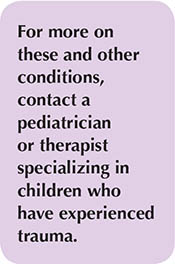I hear various conditions described when referring to foster children and I’m not sure what some of them are. Can you define some of the more common terms and tell me how to get more information about these and other conditions I have questions about?
This is a great question and one that NC Kids gets quite frequently. Let’s look at some of the more common conditions and find out what they mean. We’ll also differentiate between a few of the more common conditions that are easily confused.
Enuresis is the voiding of urine (“peeing”) into the bed or clothing after the age where the ability to hold one’s urine would typically be expected (age 5).
Encopresis is having bowel movements in inappropriate places such as in clothing or on the floor after the age of 4. This can be involuntary or intentional.
Pica is a pattern of eating non-food materials (such as dirt or paper) lasting more than one month. Children with pica may eat clay, dirt, hairballs, ice, paint, sand, etc.
Adjustment Disorder and Reactive Attachment Disorder
Adjustment Disorder is the development of behavioral or emotional symptoms in response to a stressor, such as abuse or neglect, or being removed from primary caretakers. Unlike Reactive Attachment Disorder, Adjustment Disorder is common—most children in foster care experience it at some point during their journey through the system. In fact, many children outside foster care develop adjustment disorders in response to stressors such as chronic illness and divorce.
Reactive Attachment Disorder is a rare condition in which children exhibit emotionally withdrawn and inhibited behaviors. Because the child’s basic needs for comfort, affection, and nurturing haven’t been met, the child’s growing brain may be permanently altered. This creates difficulty establishing loving and caring attachments with others and hurts their ability to establish future relationships. For more on diagnosis and treatment of RAD, see this article from Children’s Services Practice Notes: https://practicenotes.org/v19n3/RAD.htm.
Dysthymia and Depression
 Two terms people often confuse are Dysthymia and Depression. Dysthymia is a sad, dark, or low mood experienced almost every day for a period of at least two years. The symptoms are less severe than major depression and include feelings of hopelessness, insomnia, low energy, low self-esteem, poor appetite or overeating, and poor concentration.
Two terms people often confuse are Dysthymia and Depression. Dysthymia is a sad, dark, or low mood experienced almost every day for a period of at least two years. The symptoms are less severe than major depression and include feelings of hopelessness, insomnia, low energy, low self-esteem, poor appetite or overeating, and poor concentration.
Depression involves similar symptoms that are more acute and intense than Dysthymia. Depression engulfs a person’s day-to-day life and interferes with one’s ability to work, study, eat, sleep, and have fun. The feelings of helplessness, hopelessness, and worthlessness are intense and unrelenting, with little, if any, relief. These feelings persist for two weeks or more.
For more information on these and other conditions experienced by children in foster care, we recommend contacting a pediatrician or child therapist specializing in children who have experienced trauma. If a family decides to use the Internet to obtain more information, we recommend using reputable websites such as https://www.apa.org/ and https://www.webmd.com/.
Response by the NC Division of Social Services. If you have a question about foster care or adoption in North Carolina you’d like answered in “A Reader Asks,” send it to us using the contact form here.


